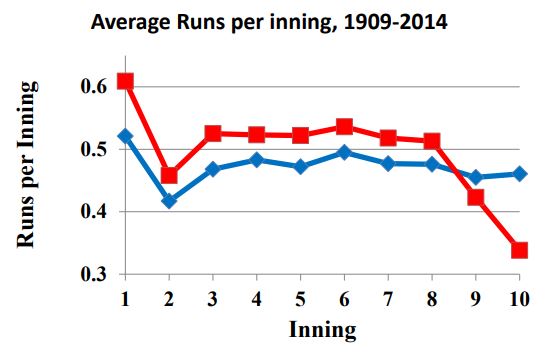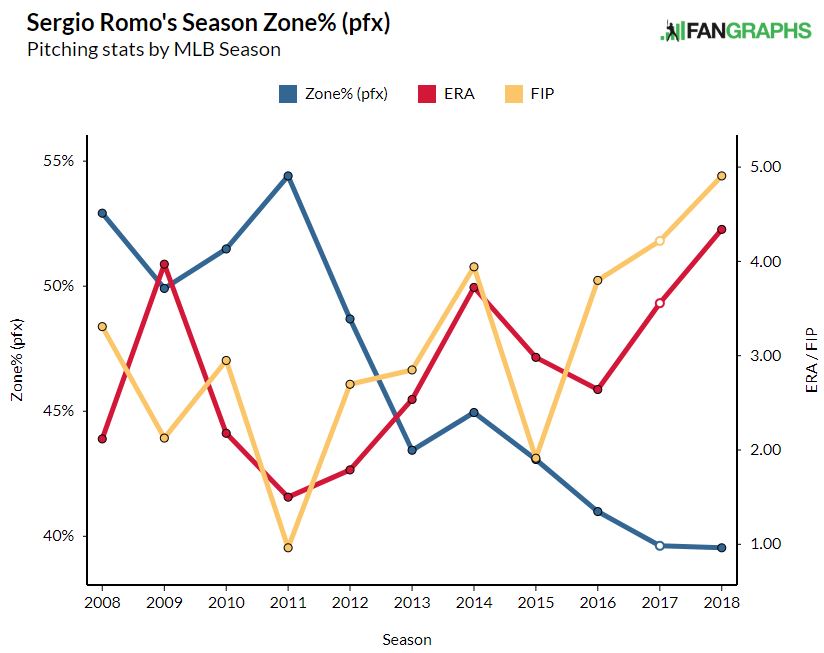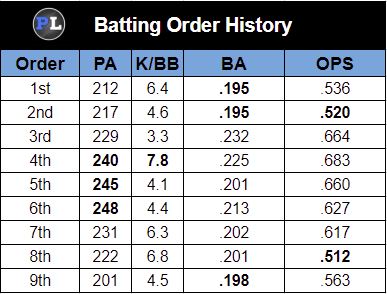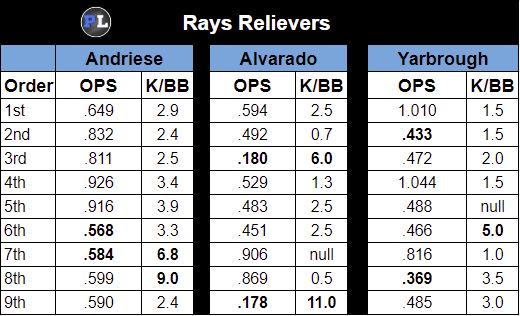(Photo by Cliff Welch/Icon Sportswire)
This past weekend, the Tampa Bay Rays participated in the pitching philosophy known as ‘Bullpenning’. Basically, Bullpenning is using your relief pitchers in various ways that don’t necessarily include following the traditional starter. The idea is to put your best arm (given the circumstances) in for the first inning or two; more than likely your strongest bullpen arm. Let them unload on the top part of the order and hand the ball off to whomever after an inning or two. The reason behind creating and using ‘The Opener’ is that the most runs are scored in the first inning. Chart 1 exemplifies runs scored per inning from 1909-2014 (via Retrosheet)

CHART 1, red is AL, blue is NL
Think about the later innings of a ballgame for a moment. Your team is up by one (or two) runs. In order to preserve that lead, you want your best relievers lined up to keep the opponent from scoring. The problem is those are usually the times when the game sees the fewest runs allowed. Those pitchers are (usually) skilled at preventing baserunners in the short term (most of the time) and typically have clean innings. By then, the batting order is already skewed and are there are pinch hitters (of lesser value) in the lineup.
You could argue that the reason there are fewer runs scored during later innings is the quality of pitching in those situations. So wouldn’t it make sense to move those guys to the early innings and have them impact the game from that perspective? Because this is a new practice, there isn’t a way (yet) to see if the balance of runs will shift towards the later innings. Let’s keep the fundamental ideas near the forefront of your mind while we examine how this process works out.
The Rays utilized reliever Sergio Romo as ‘The Opener’. This is a bit curious to me because Romo has some of the worst numbers in the Rays’ bullpen. His ERA (4.34) is somewhat in line with his FIP (4.91), he’s giving up a lot of hard contact (40.4%), his WHIP is way above normal, and he’s walking batters at a higher rate than he has in his career.
Allow me to interject the point of view (which I don’t necessarily subscribe to) that late-inning pitchers don’t have the mental makeup to pitch early in games; that their comfort level will be thrown out of whack having to pitch under different circumstances. Well, if Romo is struggling late in games, then the Rays did the right thing taking Romo out of that pitching environment and allowing him to go full-throttle for the first inning or so.
Let’s look at Romo’s plate discipline metrics displayed in Chart 2.

CHART 2
The two main plate discipline aspects check out; he gets hitters to chase and misses bats. The big problem this year is his apparent struggle to hit the strike zone; not terribly troubling because Romo has always hit the zone much less than league average. Chart 3 shows his career ERA and FIP versus his zone rate. You can see from 2014 on that his ability to hit the strike zone has been on a downward slope and his ERA/FIP continues to trend upwards.

CHART 3
Wouldn’t that put the Rays at risk for playing behind early in the game, since his command isn’t up to par? In 2018, the first and sixth inning has been the best inning in terms of runs allowed for Tampa Bay; .36 in the first, .33 in the sixth. On the other hand, the second and eighth innings have been the toughest; .64 and .80 respectively. Romo, if he continues to be as effective in the first as he was this weekend, will need to get through two innings as much as possible for this project to be successful.
So the decision to use Romo as the ‘Opener’ still doesn’t make much sense. When you look at the other arms available in the bullpen (Matt Andriese, Jose Alvarado, Ryan Yarbrough), you have to wonder why Romo was the choice to open. He hasn’t started a game in his career until this past weekend, so looking into his performance in early innings can’t and won’t qualify him.
Well, here is the reasoning behind the strategy of Romo opening the game:
“The way that their lineup stacks generally speaking is very heavy right-handed at the top,” manager Kevin Cash said when asked about the plan after Thursday’s game. It allows us in theory to let Sergio to come in there and play the matchup game in the first, which is somewhat unheard of – up until Saturday anyway. Then Yarbs can, in theory, have the availability to get deeper in the game. There’s no more secret about the third time through the order, everybody knows that. And that’s kind of what this is about.”
That makes perfect sense to me, on paper anyway. So, what has Romo’s success been like dealing with right-handed hitters? He’s been pretty dominant. 7.37 K/BB rate, .188 BAA, and a .555 OPS.
However, here is where I see a problem. What’s the easiest way to score in baseball? Hitting a home run of which Romo has allowed a total of 38 versus righties and 14 versus lefties. While his career numbers (which aren’t terrible) against lefties aren’t nearly as good, he has still allowed fewer homers versus LHB when you scale his ABs to his right-handed ABs. Using his last three years of data shows basically the same scale.
Regardless, Romo definitely works better against righties despite his propensity to give up the long ball which is nearly two per nine innings this season. Home runs aren’t everything to a pitcher but it is Romo’s Achilles heel this year. His fly ball rate is a bit raised in 2018 and HR/FB rate is currently 10% higher than his career average (and nearly 5% more than in 2017). I don’t know if I’d want a guy who has the potential to put runners on base due to control issues knowing the high-risk for allowing a home run.
Let’s break it down more and look at his track record in terms of the batting order as shown in Chart 4. I’m not referencing his innings history because he typically doesn’t come in until the 6th inning or later.

CHART 4
Romo has the most experience versus the middle of the lineup and has been generally more effective pitching to the number four and number two hitters. The high K/BB rate against the number four hitter could be explained by the penchant of that hitter to swing away more than any others in the lineup. However, we need to give Romo credit for his ability to get that hitter out with little to no damage in the process. Overall, his success against the number two hitter seems to be the best; the spot that tends to be occupied by the team’s best hitter.
OK, so Romo does well at reining in the first two hitters in the lineup, though struggles a bit with the third, fourth, and fifth hitters (in terms of OPS). Getting those first one or two outs drop run expectancy significantly to where you can make a mistake to the middle of the order and limit the damage so long as there aren’t any runners in scoring position.
To be sure that Romo is, in fact, the best option, have a look at the three Rays relievers I mentioned earlier. Note that Alvarado has only pitched in 56 games through two seasons, and 2018 is Yarbrough’s first season. We ought to take their performance with a grain of salt; Yarbrough’s in particular.

CHART 5
Chart 5 shows Alvarado has comparable success early in the batting order but Romo’s ability to get strikeouts at a higher rate makes him a better option. Like Romo, Alvarado doesn’t have considerable success versus righties compared to lefties, but the split is favorable. Conversely, Andriese does better against lefties and would make him a better choice to open a game with a top-heavy left-handed batting order. The trouble with that, however, lies in the big problems Andriese seems to have in the middle of the order.
I had thought about going further to demonstrate things such as times through the lineup as well as leveraged situations. Considering there isn’t much to work with as relievers rarely get through an entire lineup more than once and, if you’re good, you see many more high leverage situations than low/neutral. Furthermore, the leverage imbalance in the first inning(s) is much too volatile to garner much information to improve a decision.
So the Rays are on the right track; continue to open with Romo when possible and keep him in for the first inning or so. Obviously, they can’t do that every game but using him on a semi-consistent basis is certainly do-able. They aren’t the ideal example but they seem to have a guy they can rely on to put the team in the best position to gain control of the game early when it seems to matter most. Romo’s pioneering weekend should make the Rays more comfortable with that approach.
